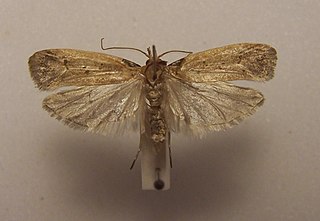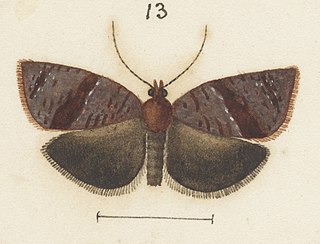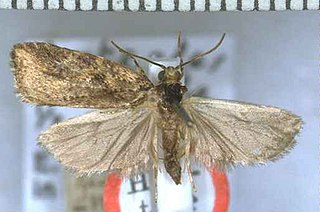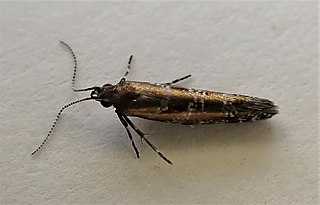
Sabatinca caustica is a species of moth belonging to the family Micropterigidae. It was described by Edward Meyrick in 1912. It is endemic to New Zealand and is found in both Southland and at Stewart Island / Rakiura. The adults of this species are variable in appearance with some specimens being mainly white on their forewings while others have forewings that are a more mottled purple-brown colour. Adults are on the wing from the start of October until the middle of December. Larvae feed on the surface of leafy liverworts.

Asterivora exocha is a species of moth in the family Choreutidae. It was first described by Edward Meyrick in 1907 and is endemic to New Zealand. This species has only been observed in the Humboldt Ranges of Otago and inhabits subalpine native bush at elevations of around 3600 ft. Adults of this species are on the wing in December and January and have been observed flying at dusk.

Glaphyrarcha is a genus of moths of the family Carposinidae. It contains only one species Glaphyrarcha euthrepta. This species is endemic to New Zealand and has been observed in the North and South Islands in the Waikato region and at Arthur's Pass. Adults are on the wing in October and November and are attracted to light. When at rest the adults of this species hold their wings scarcely overlapping and largely flat.

Amblyptilia epotis is a moth of the family Pterophoridae. It is endemic to New Zealand and is found in the South and Stewart Islands. It inhabits mountainous terrain covered in alpine vegetation or alternatively alpine wetland habitat. The adults of this species are on the wing from February to March. In appearance the adults of this species are variable in colour however this species can be distinguished from similar species by the oblique apical streak on its forewings as well as the patch of white on the costa cilia towards the apex of the forewing.

Pasiphila plinthina is a moth in the family Geometridae. It is endemic to New Zealand and is found in both the North, South and Stewart Islands. It is on the wing mainly from June until September with occasional observations up to December, and is attracted to light. This species is similar in appearance to P. sandycias but can be distinguished from it as P. plinthina has palpi that are longer and has more blurred forewing markings.

Epichorista eribola is a species of moth of the family Tortricidae. It is endemic to New Zealand and has been collected on the Westcoast of the South Island. The adults of this species are on the wing in January and inhabit damp forests.

Pyrgotis eudorana is a species of moth of the family Tortricidae. It is endemic in New Zealand and has been observed in both the North and South Islands. However it is regarded as a rare insect. This species inhabits native forest. Larvae exclusively feed on Muehlenbeckia australis and adults are on the wing from November to April. Adults are attracted to light.

Eudonia zophochlaena is a moth in the family Crambidae. It was described by Edward Meyrick in 1923. It is endemic to New Zealand. It has been hypothesised that this species is a North Island endemic. The adults of this species are on the wing from December until February. The larvae of this species are leaf miners of the leather-leaf fern Pyrrosia eleagnifolia.

Thambotricha is a monotypic genus of moths in the family Epermeniidae. Its sole known species, Thambotricha vates, is also known by the vernacular name wonder-haired prophet. It is endemic to New Zealand. This species is classified as "At Risk, Naturally Uncommon" by the Department of Conservation.

Proteodes profunda is a species of moth in the family Depressariidae. It is endemic to New Zealand. This species has been collected in its type locality of Mount Holdsworth in the Tararua Range, Raurimu near Tongariru National Park, at Days Bay in Wellington, at Mount Arthur, Otira, Invercargill, and in Southland. P. profunda lives in beech forests at altitudes of around 2000 ft and larvae feed on beech tree leaves. Adults of this species are on the wing from November to February.

Mallobathra angusta is a moth of the family Psychidae. This species is endemic to New Zealand.

Mallobathra cataclysma is a moth of the family Psychidae. It was described by Charles Edwin Clarke in 1934. This species is endemic to New Zealand and has been observed in Otago. Adults are on the wing in January and have been collected just before sunrise at the bushline in native Nothofagus forest.

Mallobathra memotuina is a moth of the family Psychidae. It was described by Charles Edwin Clarke in 1934.This species is endemic to New Zealand and has been observed in and around Dunedin. Adults are on the wing in November and December and have been collected just before sunrise.

Mallobathra tonnoiri is a moth of the family Psychidae. It was described by Alfred Philpott in 1927. This species is endemic to New Zealand and has been observed in the South Island. Adults are on the wing in December.

Tingena berenice is a species of moth in the family Oecophoridae. It is endemic to New Zealand and has been found in the North and South Islands. It is a brightly coloured species which is on the wing in November. Its preferred habitat is mixed beech forest.

Tingena chrysogramma is a species of moth in the family Oecophoridae. It is endemic to New Zealand and is found in the North and South Islands. The adults of this species inhabits open scrubland and are on the wing in January and February. It has been collected via light traps and beating shrubs. During sunny days this species has been observed resting on leaves and rarely flies. It is regarded as a rare species and has a possible association with Prumnopitys ferruginea.

Tingena morosa is a species of moth in the family Oecophoridae. It is endemic to New Zealand and has been found in the South Island in Nelson including at the Dun Mountain and in the Canterbury region. This species inhabits native forest at altitudes from 2000 to 3000 ft. Adults of this species are on the wing in December.

Tingena penthalea is a species of moth in the family Oecophoridae. It is endemic to New Zealand and has been observed in Wellington and the Tararua Range. The adults of this species are on the wing from December until February.

Atomotricha isogama is a moth in the family Oecophoridae. It was first described by Edward Meyrick in 1909. This species is endemic to New Zealand and has been observed in the North and South Islands. Larvae are leaf litter feeders and have been recorded as emerging in the New Zealand spring. Adults have been observed on the wing from July to January.

Chrysorthenches drosochalca is a species of moth in the family Plutellidae first described by Edward Meyrick in 1905. It is endemic to New Zealand and has been found in the North and South Islands. The larvae are leaf miners of Prumnopitys ferruginea. Adults are on the wing from January to March.





















